#1 - January 2025 - Zakuzaku Actors
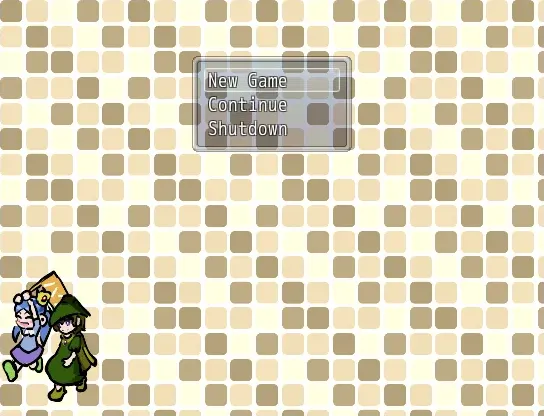
For the first (hopefully of many) posts to come, I've decided to talk about a very certain RPGMaker game that, if you saw me posting in a couple of places, you've probably noticed I was not capable of shutting up about it for the approximately the entirety of December 2024 - January 2025. Sorry, but to be fair, it's probably one of the most soulful RPGMaker games I've ever played.
My initial focus when I decided I want to start doing this in 2025 was to just write some short-form rambling pieces about neat games I like, share some neat or funny screenshots here and there, but of course, since the first title is a really, really, REALLY long game... well, so it goes.
So, what the heck is Zakuzaku Actors exactly?
Zakuzaku Actors (also known as ZakuAku, which I'll be using for brevity) is the creation of hamusuta, who before this also created a much less popular but still very cool RPGMaker game known as Random Dungeon. Both Random Dungeon and ZakuAku are, at the time of this post, available in English thanks to the herculean efforts of Rusty Cradle Translations. As someone who does not know Japanese, I and many other people would not have access to these games in English without their work. I cannot possibly begin to stress how utterly big both of these games are and how amazing it is to have these accessible to a new audience.
You don't need to have played Random Dungeon to understand ZakuAku--although there are some explicit references and callbacks in the game, they're not integral to understanding or appreciating ZakuAku--though playing it does help provide a nifty frame of reference since they do share a good bit of DNA.
ZakuAku came out in 2012 and was being continually updated through 2020 and beyond, while Random Dungeon came out back in 2009 and contains many mechanics and gameplay ideas that would return in more refined formats in ZakuAku. A focus on challenging boss fights that require changing equipment to meet changing demands--status resistances, elemental resistances, or even access to certain skills that only unique pieces of gear may provide, as well as boss gimmicks that may demand that you change your approach on how to defend or deal meaningful damage. And, beyond all that, there is just a lot of Stuff--it is a LONG game that can easily last you 100 hours, and along the way you'll be finding new items, unlocking new things (passive abilities, etc) at your home base that will influence further dungeon runs, tackling new dungeons, and so on.
And all of that does have ample story to go with it, too. Despite what it might look like on the surface--there's a lot of stock assets, and dungeon runs mainly involve going through set floors but with variable events and treasure resulting in a lot of gameplay where you're seeing the same maps repeatedly but with different things on them--there's a lot going on. Not just main plot either--you'll see all kinds of brief, mini-cutscenes all the time with lots of goofy slice of life stuff involving the main party, sometimes triggered just by finding certain items. I write this mainly to emphasize that it is a game that definitely has a lot of stuff to engage with mechanically, but it's also backed up with frequently funny dialogue and even occasionally quite serious plot events, and you'll get to spend a LOT of time knowing the main cast intimately.
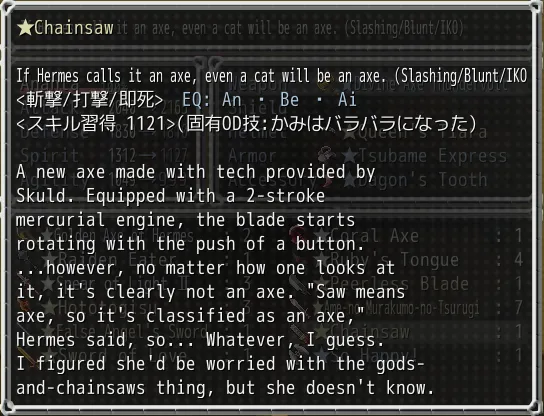
It also honestly has a frightening amount of text, given that every single item and bit of equipment has an encyclopedia entry that has a full screen's worth of text. Some contain actual lore, others are more on the silly end of things, but they serve to provide a lot of fun flavor to a game where, between story segments, there's lots and lots of running through somewhat repetitive dungeons and fighting.
It's also pretty big on yuri for those who are fans of that. So is ZakuAku. Not that I'm going to suggest someone go play one 70+ hour RPGMaker game followed by another 100+ hour one for just the wlw pairings (you should do this actually), but... just saying, you know?
Actually talking about the game this post was meant to be about...
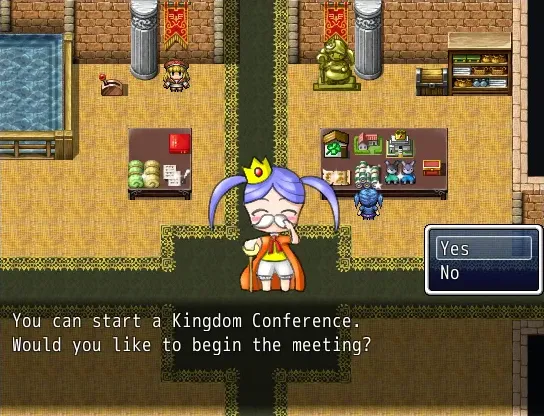
Yeah, sorry.
As mentioned, ZakuAku is from 2012 and continued development for a long time after that. Version 1.87 of the game came out back in March 2023 and, based on hamusuta's own messages in the developer room after completing the main story, is likely the final iteration of the game as far as I can tell. You wouldn't necessarily realize the development time of the game if you looked at the first 5-10 hours of gameplay which don't feel like they're anything too special. Gone are all the stock portraits that Random Dungeon used, now replaced by hamusuta's own art. And, while I do love it, it's also obviously not professional art. That's not a slight on it! I love it, and you'll actually see a lot of progression in their art over the course of the game. Some of this is due to redraws--there's some text in the developer room mentioning struggling with the urge to constantly redraw some things--but some of it is just plain old improving and refining their style.
Even beyond the early art maybe not looking the best at times and the early gameplay being a little dull due to a lack of options and party members, the early story isn't terribly exciting either. You play as a Hagure girl named Delichi, one of many victims of summoners becoming reckless and just yanking people without a care in the world from other worlds. The Hagure are now stuck in this new world, are generally discriminated against, etc. It's a rough time for them. Delichi's wish is to make one big Hagure Kingdom to welcome all the Hagure with open arms, and her adoptive mom Rosemary, who is a modestly skilled mage with a keen eye for strategy and a keener eye for rare moss, is there to help her along the way. In practice, this means a chunk of the early game is dedicated to "go here, recruit this person, now go here, recruit this person" for a while until the real plot starts to slowly kick in.
I'll be honest--the early plot stuff just isn't super exciting and the game in general does take some time to really find its legs. It's not that playing the game is bad or anything, but in my opinion it's a lot more engaging once you start having real options on party members and are really picking and choosing who to bring with you. It's a little like Labyrinth of Touhou 2 for me in that sense, where I'm personally waiting--sometimes for pretty long periods of time!--to recruit my favorites so I can organize my party around them specifically.
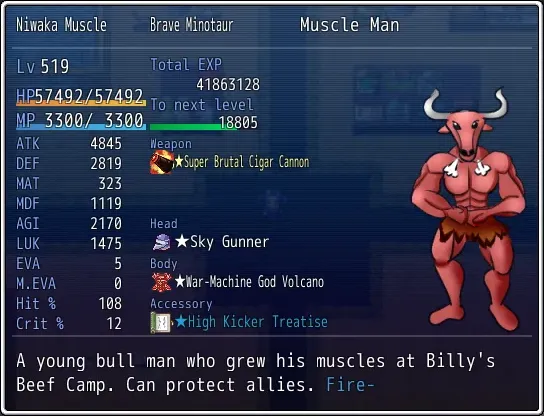
That said, there is a fun cast of folks who do join you. There's Niwaka Muscle, an alarmingly muscular cowman who functions as the party's tank early on and is the butt of a great many beef jokes. Hapiko, a harpy who's a huge fan of ste-- ... ah, acquiring things, functions as a speedy low HP attacker who can steal money from enemies. Lady Tea-Tea, a diminutive goddess who resides in a tiny teacup and functions as a powerful healer. Berberos, an adorable three-headed dog who supports the party with his fire breath and his healing licks. There's dozens of other characters on top of that who join over the game's duration and while some occasionally have overlapping roles in terms of gameplay, they all are perfectly usable characters that can be used in your 8(!)-man parties, with their own unique skills and frequently innate status resistances or elemental affinities. Even the Hagure Kingdom's blacksmith is capable of knocking heads around with her hammer.
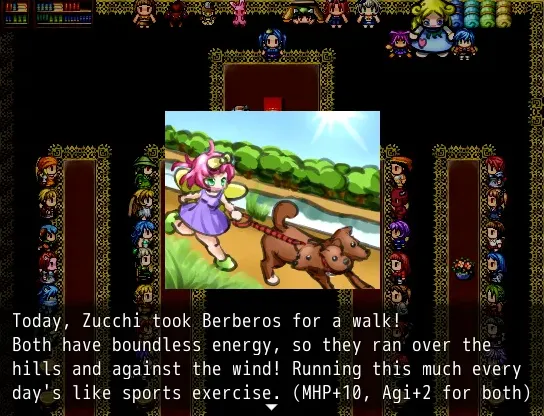
Fast forwarding a bit, what starts off as just collecting a bunch of new friends eventually leads into the establishment of the Hagure Kingdom as an actual proper place in the story. Party members will put forth suggestions for facilities, stores, and other attractions that you can pay your hard-earned money to build, and these all have mechanical benefits. Resting back at the kingdom also leads to lots of short cutscenes where your party members interact with each other, and they tend to generally be quite funny and are a nice way for some less important party members to still have a voice. Many of these do not necessarily involve Delichi at all or may just involve her for one last-second gag at the end. Personally, I always appreciate this since I kind of enjoy it when more minor characters get to interact without necessarily being in the protagonist's orbit.
And really, that's kind of where a lot of the charm is for me. Delichi is the main character, yeah, sure, but the game places a lot of emphasis on all the other members of the kingdom and their quirks and sometimes questionable talents, all working together as one big found family. While I won't pretend every party member gets 100% equal attention, given some of them can't even talk, you do have a pretty big cast of weirdos and goofballs (said affectionately) that all get a lot of screen time in various slice of life rest events, reminiscent of Random Dungeon, and the kingdom conferences.
And, since I haven't actually explained what a kingdom conference is yet, that is a mechanic where the kingdom gets together between plot beats and you get a rundown of various random events that transpired off-screen (Hao went hunting and brought back some healing items in the form of food! Hapiko went... uh, well, stealing, and brought back some extra gold! Delichi and Berberos won another dog-racing competition! Niwaka Muscle spontaneously grew a beard and learned Beard Dance...?!) that all provide benefits to the player in the form of money, healing items, or even permanent stat bonuses, but also serve as a constant reminder that the Hagure Kingdom is an actual Thing you've built up over the course of the game. Most if not all party members also get events that can randomly play during the conferences independent from any propositions they have to build new facilities for the kingdom. What this all means is that with every new member of the kingdom, not only does the family get just a little bit bigger, but you reap more and more benefits from it.
I'll add that these conferences also come charming little pieces of art for each and every single possible event, and there are a LOT of them. If you recall me mentioning hamusuta's early art, these are especially charming since you can sort of trace the progress of when certain pieces were drawn since the art style, quality, and even resolution vary a bit. It's a fun way to remember just how much work went into this over how long of a period of time.
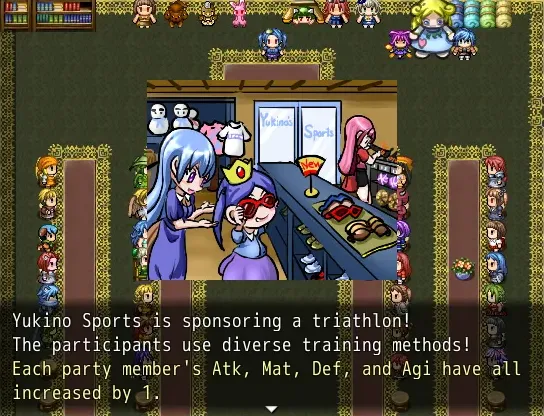
Moving on to more actual gameplay...
For the majority of Part 1 of the game--I'll get into what that means later--the game follows a simple routine. Party members at a conference put forth new search locations for Delichi and the party to go, usually in service of recruiting new party members or sometimes other unusual events like monster outbreaks, but down the line as more of an actual overarching plot takes over, they tend to be less search locations and more "okay, this is the place we're going because of Plot Stuff". So, you go to the next plot location, there'll likely be some pretty straightforward screens with enemy symbol encounters to fight or avoid as you want and some occasional sparkly bits with items to grab, and plenty of cutscenes and party chat along the way, maybe some bosses, then you return to the Kingdom, rest, hold a conference, repeat. Some of these areas are... not always great to get through, since they frequently involve enemy symbol encounters in narrow hallways.

There are some moments in the game that do shake this up quite a bit, to be clear, and even times where you'll have to form multiple parties to deal with multiple large threats, or when things otherwise get pretty intense. They're among my favorite portions of the game easily--hamusuta's quite skilled at interspersing some great dramatic or just plain cool scenes amongst the general lighthearted and goofy tone that the game maintains a lot of the time between plot beats.

Get used to seeing a lot of variations on this text, since the game is careful to warn you when you'll get a proper game over rather than Delichi just teleporting everyone back home after a lost battle.
Beyond all of that, there's an entire Dimensional Tower side-dungeon with challenge bosses galore, and each floor tends to have its own gimmick and theming as well as some unique party members you'll recruit. This trends more towards Random Dungeon style gameplay, where you'll loop through similar floors frequently but what you find there may not always be the same, and your goals are just 'fight stuff, get stronger, find new items, and beat up bosses'. These still do have actual plot, mind you, and the characters you recruit from it don't get cast off into the "optional character dimension" where they cease to exist for the remainder of the game. They get numerous rest scenes, they offer their own proposals at kingdom conferences, and the back portion of the game eventually requires you to have gotten them all anyway.
Part 1 is easily my favorite part of the game--I think the Hagure Kingdom starting as the earnest wish of one girl, backed by her adoptive mom, and becoming a fully realized family of goofballs 50+ hours later is just plain fun and charming. There are sad things that happen along the way, not everything is all sunshine and roses, but ZakuAku is generally a game that trends more towards being hopeful rather than not. There's a great mixture of story and gameplay there once you break free of the first 10-15 hours, and perhaps the worst thing I can say is the final floor of the Dimensional Tower takes a little too much grinding to finish the story events.
Wait. 50 hours? Part 1..?
... Yeah. So, anyway, then there's an Interlude after that. It's somewhat divorced from the main story, but can easily run another 30-40 hours by itself, and is much more gameplay heavy, and concerns the party exploring a brand new Maou Tower that has a spooky unknown Daimaou in charge.
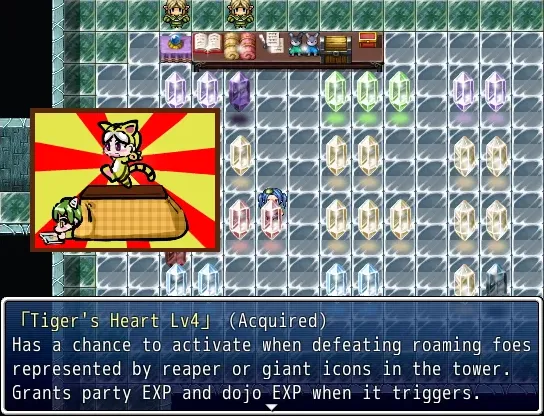
If you've played Random Dungeon, seeing these crystals might inspire certain feelings...
If the Dimensional Tower reminds one of Random Dungeon, the Daimaou's Tower is that but even more-so. Runs of it will see you harvesting a new resource, TE or Tower Energy, that you use to power up crystals that all give you permanent passive buffs in the tower--to increased experience points for beating dangerous foes, increased MP regeneration between floors, a chance to find special "hell" or "heaven" floors, improving treasure chests, even opening a new casino, or eventually unlocking... well, an entire continuation to the story.
Somehow, despite knowing that last one was coming, it still floored me a little bit.
For some, I suspect this will be a weaker part of the game since there's a marked decrease in story and much more of a focus on dungeon crawling. Your party does become appreciably stronger in a way that feels good, and so do the opponents you face, and some bosses start asking for slightly more specific tactics to deal with their gimmicks. You may have to start being more conscious of strategies before a fight instead of just going in and winging it blindly. Or just keep leveling up more and finding better equipment--that's still a totally valid strategy.
... Personally, I like it when my numbers go up and when I find new equipment and my party just gets stronger, so I still really liked the Interlude even if it's sort of nothing plot-wise. It's just not as good as the rest of the game, in my opinion, but I had a lot of fun.
But wait, there's more!
You might remember I mentioned ZakuAku came out in 2012 and was still being updated as of 2023. Well, what if I told you that one of the last things you unlock in the Part 1 interlude is a very summer-y themed portion of the game that makes up an entire Part 2 of the game that lasts another 50+ hours?

Just look at this new Berberos art in part 2. Look at it!!
It's incredibly extensive. Every single character in the game gets new art--it's summer, after all, so that means lots of swimwear for everyone. It's technically divided into three portions, with the first two featuring smaller specific set parties off doing their own thing, and then the final portion being the proper Part 2 leg of the game which is its own fully realized main scenario.
I won't go into Part 2's specifics very much because a lot of it is very cool and definitely just needs to be seen, but it adds a ton of new mechanics to the game and spends plenty of time shining the spotlight on the whole cast again through various sidequests and events. The one new mechanic I will call out is that you get to elect party members to various positions, like Chief Guard or Chief of Staff, Chief Chef, and so on. These all confer actual gameplay benefits that help make characters stand out more, or let a player make their favorites stronger since these roles can confer new passive or active skills, though not every character can be assigned every role.
The writing does change a little bit in Part 2 due to a slight PoV change and some new characters that you meet, but it's still an enjoyable ride with some good twists along the way, and the gameplay is more like Part 1 rather than the Interlude. The key difference is that instead of members of the Hagure Kingdom offering suggestions on where you need to go next, you're now going out and about and finding your own dang work, sometimes either receiving letters asking for aid, or you simply talk to NPCs (or your party members!) yourself and find out about jobs to do, like UFO hunting. Or a brief stint as a defense attorney. Normal stuff.
Okay, but then the game's over, right?
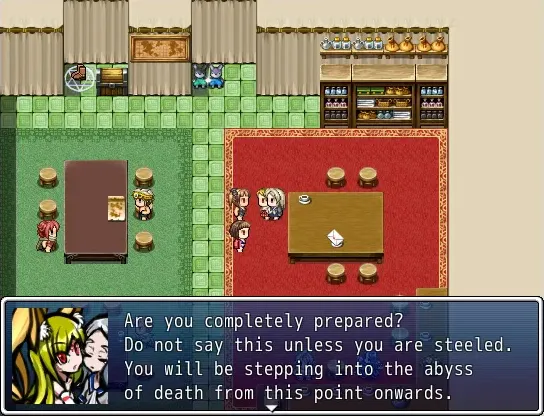
... Nope. So, at this point you're probably over 100 hours deep easily. There's just what seems to be the final boss remaining, and then... hey, wait, what's this about a new dungeon...?
I made various kinds of faces once I saw what that new dungeon was. Confusion, despair, a little bit of manic excitement.
That new dungeon is basically an entire other branch of the game. It's basically the Dimensional Tower/Daimaou Tower on steroids, incorporating even more new mechanics (supporter party members who are all new characters who join you and provide passive effects! new events! lots of new minigames!) and even more story content. While those wishing to simply finish it to see the true final ending to ZakuAku's story can probably wrap it up by the 140-150 hour mark, even beyond that, there's a variety of nutty superbosses for the truly dedicated grinders, as well as an item compendium that tracks your overall % progress of items you've found. There's even NPCs who track all the individual events you've seen in this new dungeon, so you'll be able to truly know when you've seen everything there is to offer.
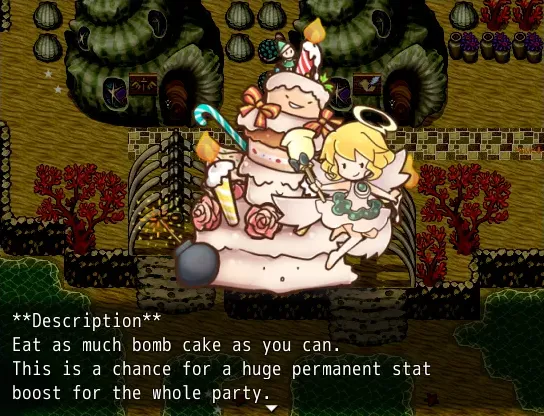
Personally, I don't think I'll ever do all of the 100% completion tasks--I cannot state enough how much of a grind it'd be to do everything--but for those who truly love making their numbers go up and devouring every bit of content in a game, there's plenty for you.
Other odds and ends
So, moving onto some general stuff that I personally enjoyed a lot in ZakuAku.
I've already hinted here and there above about liking the general tone of ZakuAku's writing--it is frequently incredibly silly, but also punctuates that with moments of real gravitas and a couple of nail biting moments where I legitimately wasn't sure what was going to happen next. The cast is generally pretty fun, to boot, with a lot of oddballs who are all charming in their own way. A girl who's a snowman kicker, a somewhat chuuni psychic, a certified Dad beastman who's a battle-hardened veteran, a dragon who resides under a kotatsu, a self-proclaimed daimyo, a scylla with some interesting hobbies... the Hagure Kingdom has all kinds of folks in it.
It was frequently a problem playing this game that I'd never be quite sure who I wanted to use since I would tend to pick based on favorites rather than who might be mechanically useful at any given time. It turns out the answer to who I liked was.. well, a lot of the characters. Picking favorites is a totally fine way to play, too, since there's food items that permanently boost stats, and there's plenty of rare or unique gear that you can shove onto your favorites first. Same with teaching them new skills, of which you'll keep finding throughout the whole game. But, of course, even a character who hasn't benefited from dozens of stat boosters can still be ready to go at a moment's notice--just slap on some appropriate equipment, teach them some up-to-date skills with the library's worth of skill scrolls you'll be sitting on, and they're all good.

ZakuAku does partially sidestep this "argh, too many characters, who do I use?!" problem by having an 8-man party system. Fights have a front and back row with 4 people each, but at any time at the start of your turn you can swap anyone in the front from anyone to the back, as many times as you want, including dead people. No cost associated with it. This means fights end up being a lot more dynamic and places higher emphasis on planning your turns. Some bosses may have clear tells for when they're going to do big attacks, so swapping in people more suited to tanking helps, but ZakuAku is a game where buffs and support items are very strong for both offense and defense--do you keep your damage dealers out and try to prep them for the boss's downtime so you can land your big hits sooner to close out the fight? Do you just take a turn to stall and prep your offense later when you think you're in a stable condition? When do you actually revive people? Most strong items also have limited carrying capacity, so when do you bust them out?
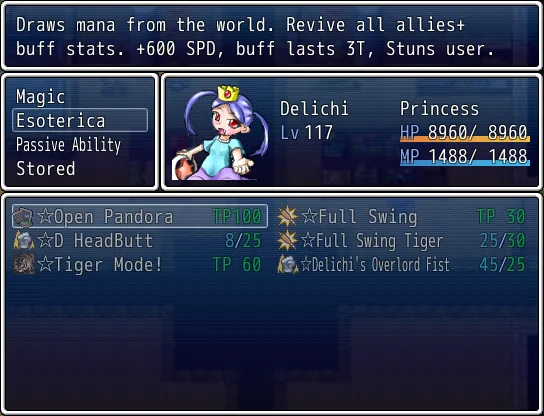
An extra complication to this is that besides the usual HP/MP bars, there's TP which is a per-fight resource that's easy to build and easy to spend but is used to power stronger, more character-defining moves or higher power generic skills. Delichi has her iconic 'Open Pandora' move at 100% TP that revives the entire frontline but stuns her. Niwaka Muscle can force enemies to attack him while also fully recovering his HP. Some healers may have very strong AOE heals with other useful effects tacked on at the expense of a lot of their TP. Some damage dealers may have very potent self-buffs or crushingly strong damage buttons linked to their TP. You start most fights with a random amount of TP, and most actions build TP, but so does being hit--thus, outside of very specific circumstances, your back row isn't really gaining TP. Someone who you keep in the back row all the time may not be ready to contribute in a pinch.
Incidentally, buffs and debuffs don't expire in the back row, so there's an extra layer of planning here. You can buff an attacker and hide them away until there's a good time for them to do damage, or even put sleeping party members in the back since there's status cure spells that can target the back row. Or simply because you just can't afford the lost action and need to replace them with an actual combatant and deal with curing them later.
Not every boss is a life or death struggle, mind you. The game is often kind, and Rosemary or other party members will generally call out boss gimmicks and explain them as best they can, or will provide big hints on things you can do to gain the advantage. Up to Part 2, there's really only a small handful of very challenging bosses that'll give you multiple game overs, but the remainder can be beaten with fairly standard gameplay as long as you take advantage of swapping party members in and out, healing and recovering as needed, and paying attention to any gimmicks they may have.
.. No promises on the post-game dungeon for Part 2, though. A couple of those bosses are just plain mean.
It'd be a massive failure on my part to also not point out ZakuAku's soundtrack. There's a handful of composers who contributed songs for it, some of which you may have even heard in other RPGMaker or doujin games. If you're an ASTLIBRA enjoyer, you'll definitely recognize a couple of tracks. Some were composed specifically for the game--Mozell in particular composed a lot of boss themes that are all excellent and put to very good use, since they tend to accompany particularly challenging bosses. I even picked up a couple of Mozell's albums after I finished up the game.
In the end...
If it isn't absurdly obvious by now, I like ZakuAku a lot. I think it's legitimately a wonderful game both mechanically and in terms of the story. It sometimes gets a little cheesy, and there is one character who I could do with less of due to some... unfortunate jokes. And, of course, I will acknowledge it's just plain long.
But even with all that aside, I genuinely think this game is worth playing. There's so much soul and passion here, and the game is legitimately excellent once you're past the very beginning.
Most importantly, probably don't do what I did and marathon whole damn game. I mean, you can if you want, but...
I guess to sum all this up, if this rambling hodgepodge of words about this fun little game ends up inspiring you to play it, I truly do hope you enjoy your time with the Hagure Kingdom as much as I did.
Give Delichi some extra pudding, she's a hard worker.